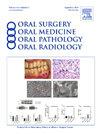Clinical factors associated with salivary flow rate in adults with acromegaly
IF 2
3区 医学
Q2 DENTISTRY, ORAL SURGERY & MEDICINE
Oral Surgery Oral Medicine Oral Pathology Oral Radiology
Pub Date : 2024-08-16
DOI:10.1016/j.oooo.2024.08.009
引用次数: 0
Abstract
Objective
To investigate the stimulated salivary flow (SSF) and unstimulated salivary flow (USF) in adults with acromegaly and to identify possible clinical factors associated with salivary flow.
Study design
A case-control study was conducted with a group composed of adults diagnosed with acromegaly (n = 29, mean age = 50.2 years) and a control group (n = 29, mean age = 54.3 years). Variables for socio-demographic characterization, lifestyle habits, and diabetes diagnosis, body mass index (BMI), cervical circumference (CC) and abdominal circumference (AC) were collected. USF and SSF variables were analyzed as outcomes. Unpaired t-test, Pearson's correlation, and multivariate regression models were used for statistical analysis.
Results
Both groups were 44.8% male and 55.2% female. Diabetes was present in 55.2% of the acromegaly group and in 51.7% of the controls (P = .792). The acromegaly group had a higher USF than the control group (0.50 mL/min versus 0.22 mL/min). SSF showed a direct correlation with CC (r = 0.470, P = .010). Acromegaly was associated with higher USF (standardized coefficient = 0.780, P = .039), and age was inversely related to USF (standardized coefficient = −0.333, P = .013).
Conclusions
The findings suggest that adults with acromegaly have an increased USF and that being older is associated with a decrease in USF.
与肢端肥大症成人唾液流量相关的临床因素
研究肢端肥大症成人患者的刺激性唾液流量(SSF)和非刺激性唾液流量(USF),并确定与唾液流量相关的可能临床因素。研究人员对确诊为肢端肥大症的成年人(29 人,平均年龄 50.2 岁)和对照组(29 人,平均年龄 54.3 岁)进行了病例对照研究。收集的变量包括社会人口特征、生活习惯、糖尿病诊断、体重指数(BMI)、颈围(CC)和腹围(AC)。将 USF 和 SSF 变量作为结果进行分析。统计分析采用非配对 t 检验、皮尔逊相关和多变量回归模型。两组患者中,男性占 44.8%,女性占 55.2%。55.2%的肢端肥大症患者患有糖尿病,51.7%的对照组患者患有糖尿病(=0.792)。肢端肥大症组的 USF 比对照组高(0.50 mL/min 对 0.22 mL/min)。SSF 与 CC 呈直接相关(r = 0.470,= 0.010)。肢端肥大症与较高的 USF 相关(标准化系数 = 0.780,= 0.039),年龄与 USF 成反比(标准化系数 = -0.333,= 0.013)。研究结果表明,成人肢端肥大症患者的USF增加,而年龄越大,USF越低。
本文章由计算机程序翻译,如有差异,请以英文原文为准。
求助全文
约1分钟内获得全文
求助全文
来源期刊

Oral Surgery Oral Medicine Oral Pathology Oral Radiology
DENTISTRY, ORAL SURGERY & MEDICINE-
CiteScore
3.80
自引率
6.90%
发文量
1217
审稿时长
2-4 weeks
期刊介绍:
Oral Surgery, Oral Medicine, Oral Pathology and Oral Radiology is required reading for anyone in the fields of oral surgery, oral medicine, oral pathology, oral radiology or advanced general practice dentistry. It is the only major dental journal that provides a practical and complete overview of the medical and surgical techniques of dental practice in four areas. Topics covered include such current issues as dental implants, treatment of HIV-infected patients, and evaluation and treatment of TMJ disorders. The official publication for nine societies, the Journal is recommended for initial purchase in the Brandon Hill study, Selected List of Books and Journals for the Small Medical Library.
 求助内容:
求助内容: 应助结果提醒方式:
应助结果提醒方式:


